

NOLA Express — Browse by title — Independent Voices. Gulf Coast grassroots resistance journalism. Tricentennial Reading List. 1 Dead in Attic: Post-Katrina Stories by Chris Rose. TOM PIAZZA - Tom Piazza. Lafcadio Hearn. Greco-Japanese writer Patrick Lafcadio Hearn (/hɜːrn/; Greek: Πατρίκιος Λευκάδιος Χερν; 27 June 1850 – 26 September 1904), known also by the Japanese name Koizumi Yakumo (小泉 八雲), was a writer, known best for his books about Japan, especially his collections of Japanese legends and ghost stories, such as Kwaidan: Stories and Studies of Strange Things.

In the United States, Hearn is also known for his writings about the city of New Orleans based on his ten-year stay in that city. Born in Greece to a Greek mother and British father, a complex series of conflicts and events led to young Lafcadio Hearn being moved from Greece to Ireland, where he was abandoned first by his mother (leaving him in the care of her husband's aunt), then his father, and finally by his father's aunt, who had been appointed his official guardian. At the age of 19 he was put on a boat to the United States, where he found a job as newspaper reporter, first in Cincinnati, Ohio, and later in New Orleans. Life[edit] Blacksad. Blacksad is a comic album series created by Spanish authors Juan Díaz Canales (writer) and Juanjo Guarnido (artist), and published by French publisher Dargaud.

Though both authors are Spanish, their main target audience for Blacksad is the French market[1] and thus they publish all Blacksad volumes in French first; the Spanish edition usually follows about one month later.[2] The first volume, Quelque part entre les ombres (literally Somewhere between the Shadows, but simply called Blacksad in the US), was published in November 2000. The second volume, Arctic-Nation, was published in 2003 and the third, Âme Rouge (Red Soul), was published in 2005. An English translation of the third volume was delayed due to the bankruptcy of its North American publisher, iBooks. On the Road. On the Road is a novel by American writer Jack Kerouac, based on the travels of Kerouac and his friends across the United States.
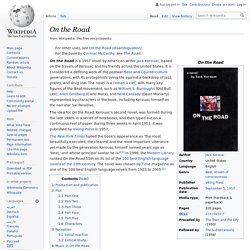
It is considered a defining work of the postwar Beat and Counterculture generations, with its protagonists living life against a backdrop of jazz, poetry, and drug use. The novel, published in 1957, is a roman à clef, with many key figures of the Beat movement, such as William S. A.D.: New Orleans After the Deluge. A.D.: New Orleans After the Deluge is a non-fiction graphic novel by cartoonist Josh Neufeld.

Originally published as a webcomic, A.D. tells the stories of a handful of real-life New Orleans residents and their experiences during and after Hurricane Katrina. The graphic novel was a New York Times best-seller and was nominated for an Eisner Award and a Harvey Award in 2010. In addition, A.D. was selected for inclusion in The Best American Comics 2010. All the King's Men. Plot[edit] All the King's Men portrays the dramatic and theatrical political rise and governorship of Willie Stark, a cynical, liberal populist in the American South during the 1930s.

The novel is narrated by Jack Burden, a political reporter who comes to work as Governor Stark's right-hand man. The trajectory of Stark's career is interwoven with Jack Burden's life story and philosophical reflections: "the story of Willie Stark and the story of Jack Burden are, in one sense, one story. "[3] The Grandissimes: A Story of Creole Life. The Grandissimes: A Story of Creole Life is a novel by George Washington Cable, published as a book in 1880 by Charles Scribner's Sons after appearing as a serial in Scribner's.[1][2] The historical romance depicts race and class relations in New Orleans at the start of the 19th century, immediately following the Louisiana Purchase in 1803.[3] The book examines the lives and loves of the extended Grandissime family, which includes members from different races and classes in Creole society.[4] The novel juxtaposes a romanticized version of the French Creole culture with the atrocities committed under the European-American system of slavery in the United States.[5] Key characters[edit] Plot[edit] Honoré Grandissime, head of the French Creole family, takes in Joseph Frowenfeld, whose family has died of yellow fever.
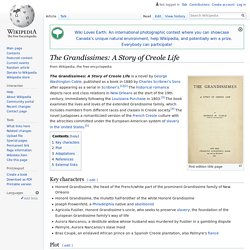
Manon Lescaut. First page of the redacted 1753 edition of Manon Lescaut Plot summary[edit] The two lovers finally end up in New Orleans, to which Manon has been deported as a prostitute, where they pretend to be married and live in idyllic peace for a while.
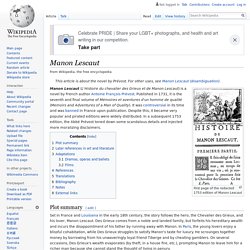
But when Des Grieux reveals their unmarried state to the Governor and asks to be wed with Manon, the Governor's nephew sets his sights on winning Manon's hand. In despair, Des Grieux challenges the Governor's nephew to a duel and knocks him unconscious. Thinking he had killed the man and fearing retribution, the couple flee New Orleans and venture into the wilderness of Louisiana, hoping to reach an English settlement. Mules and Men. Zora Neale Hurston, author of Mules and Men Mules and Men is a 1935 autoethnographical collection of African-American folklore collected and written by anthropologist Zora Neale Hurston.[1] The book explores stories she collected in two trips: one in Eatonville and Polk County, Florida, and one in New Orleans.[1][2][3] Hurston's decision to focus her research on Florida came from a desire to record the cross-section of black traditions in the state.
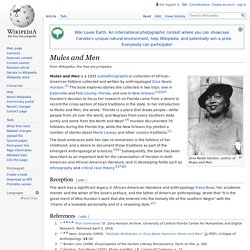
In her introduction to Mules and Men, she wrote, "Florida is a place that draws people—white people from all over the world, and Negroes from every Southern state surely and some from the North and West".[4] Hurston documented 70 folktales during the Florida trip, while the New Orleans trip yielded a number of stories about Marie Laveau and other voodoo traditions.[1] Reception[edit] The work has a significant legacy in African-American literature and anthropology. References[edit] Grace King: New Orleans, The Place and the People (1895) The work presented here is a popular history of New Orleans published in 1895 and covering the entire history of the city down to that date.

It is written in a vivid, discursive style. Now King's taste for anecdote occasionally sends her off on some rather long digressions, while history less amenable to graphic description gets short shrift, making the book a bit patchy: how New Orleans ever came to be occupied in the War between the States is never so much as hinted at, for example. (By way of counterbalance, the curious student will find a drier and more nearly complete history onsite as well).
This somewhat nitpicking scrutiny of details, however, whether to praise them or otherwise, does not do the author justice: her book is fascinating on its own very different ground. Technical details on how this site is laid out are given below, following the Table of Contents. Technical Details Edition Used Proofreading This transcription has been minutely proofread. Pagination and Local Links. Pylon (novel) First edition (publ.
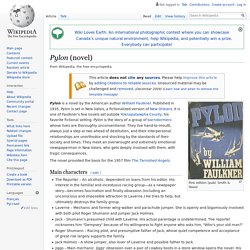
Smith & Haas) Pylon is a novel by the American author William Faulkner. Published in 1935, Pylon is set in New Valois, a fictionalized version of New Orleans. It is one of Faulkner's few novels set outside Yoknapatawpha County, his favorite fictional setting. Pylon is the story of a group of barnstormers whose lives are thoroughly unconventional. A Walk on the Wild Side. Algren noted, "The book asks why lost people sometimes develop into greater human beings than those who have never been lost in their whole lives. Why men who have suffered at the hands of other men are the natural believers in humanity, while those whose part has been simply to acquire, to take all and give nothing, are the most contemptuous of mankind.
Mosquitoes (novel) The city of New Orleans and a yacht on Lake Pontchartrain are the two primary settings for the novel. Beginning and ending in the city, the story follows a diverse cast of artists, aesthetes, and adolescents as they embark on a four-day excursion aboard the motorized yacht, the Nausikaa, owned by a wealthy patron of the arts. The novel is organized into six sections: a prologue which introduces the characters, four body sections each of which documents a day of the yacht trip hour-by-hour, and an epilogue which returns the characters, changed or unchanged, to their lives off the boat. The Pelican Brief. Plot[edit] The story begins with the double assassinations of two ideologically divergent Supreme Court Justices. Both murders are committed by Khamel, one of the most wanted terrorists in the world. Justice Rosenberg, a liberal, is killed at his home while Justice Jensen, a Republican-appointed swing voter, is killed inside a gay movie theater in Washington.
Twelve Years a Slave. The work was published eight years before the Civil War by Derby & Miller of Auburn, New York,[1] soon after Harriet Beecher Stowe's best-selling novel about slavery, Uncle Tom's Cabin (1852), to which it lent factual support. Northup's book, dedicated to Stowe, sold 30,000 copies, making it a bestseller in its own right.[3] After being published in several editions in the 19th century and later cited by specialist scholarly works on slavery in the United States, the memoir fell into public obscurity for nearly 100 years. Vieux Carré (play) Set in the late 1930s in a dilapidated boarding house at 722 Toulouse Street in the French Quarter of New Orleans, the play focuses on a nameless writer, who has newly arrived from St. Louis. He is struggling as a young man with his writing career, poverty, loneliness, homosexuality, and a cataract. He gradually becomes involved with other residents, including Mrs.
Wire, his manipulative landlady; Nightingale, an older, predatory, tubercular artist who refuses to accept his condition; Jane, a New Rochelle society girl dying of leukemia; her sexually ambiguous, drug-addicted lover Tye, who works as a bouncer in a strip club; Mary Maud and Miss Carrie, two eccentric, poor, elderly women, who are literally starving to death; and a gay photographer with a passion for orgies. Following eleven previews, the original Broadway production, directed by Arthur Allan Seidelman, opened on May 11, 1977 at the St. A Streetcar Named Desire. Cat on a Hot Tin Roof. The Awakening (Chopin novel) Ellen Gilchrist.
Ellen Gilchrist (born February 20, 1935) is an American novelist, short story writer, and poet. She won a National Book Award for her 1984 collection of short stories, Victory Over Japan.[1] Life[edit] Gilchrist was born in Vicksburg, Mississippi, and spent part of her childhood on a plantation owned by her maternal grandparents. She earned a Bachelor of Arts degree in philosophy and studied creative writing under renowned writer Eudora Welty at Millsaps College. Later in life, Gilchrist enrolled in the creative writing program at the University of Arkansas, but she never completed her MFA. Criticism[edit] A success for the recently founded University of Arkansas Press, In the Land of Dreamy Dreams (1981) sold more than 10,000 copies in its first ten months and won immense critical acclaim. Gilchrist was heard regularly as a commentator on National Public Radio’s Morning Edition from 1984-1985. Bibliography[edit] Novels Story collections Other References[edit]
A Curtain of Green. A Confederacy of Dunces. The Neon Bible. Soldiers' Pay. Other Voices, Other Rooms (novel) The Moviegoer. Christopher Rice. Interview with the Vampire. Junkie (novel) Zeitoun (book) New Orleans in fiction. The Feast of All Saints (novel) The Historic New Orleans Collection. Life on the Mississippi.